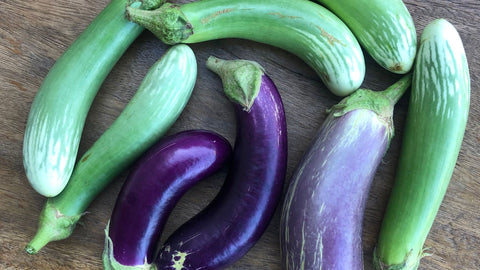Eggplant, aubergine or brinjal – however you call it, this vegetable is known around the world and each continent boasts of its own culinary version of this colorful “fruit”. In the Philippines, eggplant comes in different shapes and colors – but the most common is purple. While it is generally a tropical crop, eggplant has been grown successfully even in countries with temperate weather.
Did you know that eggplant is actually a “berry” by botanical definition? While it is actually low in nutritional value, its capacity to absorb oils and flavors through its fleshy texture makes it a favorite ingredient in the culinary world.
In home gardening, eggplant is also a must-have among vegetable growers. I remember experiencing a few hiccups when I started growing eggplants in containers a few years ago. Eventually I learned how to cultivate eggplants successfully and it’s now one of the mainstays in my veggie garden. I am sharing here a few tips I learned about growing eggplants in containers.
Container Size
Choose a 5-gallon container for a minimum size. In tropical countries like the Philippines, eggplants grow as a perennial – which means that they continue to grow and bear fruit for at least 3 years. Re-potting is hardly needed, provided that you use a well-draining pot and potting media. In container gardening, a good quality soil-less potting mix is highly recommended rather than use ordinary garden soil. Soil tends to get compacted and it eventually restricts the growth of the roots, resulting in stunted growth or root rot.

Planting Season
Eggplants are generally a sturdy plant but they do get stressed from extreme heat or cold. In the Philippines, extreme summer heat causes a lot of stress on these plants. When under stress, their flowers fall off and the leaves turn yellow or brown. Know when is the best time to start planting your eggplant seeds, and this varies according to the climate zone.
Sunlight
These plants need a lot of sunlight, so choose a location where they could be exposed to at least 6 hours of sunlight daily. Generally, eggplants can tolerate a lot of sunlight. However, too much of it may also cause the leaves to burn or the fruits to ripen prematurely. This happens especially during summer time in the Philippines where the heat index can exceed 40-degrees Celsius in some areas. Therefore, try to provide some shade especially in early afternoon.
Feeding
To keep them productive, feed them at least twice a month. Eggplants need a continuous supply of soil nutrients at the roots, especially during fruit-bearing stage. Use compost material with lots of banana peels for phosphorus and eggshells for calcium to condition the soil once or twice a month. Regular application of vermicast also helps maintain balanced nutrients for these plants.
Watering
Water them deeply at least twice a week, or when the soil feels dry. In tropical climate countries like the Philippines, it can get extremely hot during summer, so more frequent watering may be necessary. While eggplants are sturdy, and generally drought-tolerant, underwatering may cause them to produce less flowers or fruits. You can tell when the plant needs more water if the leaves start to droop.
Pruning
Lastly, prune away excess leaves and branches. Leave only 3 or 4 healthy main branches to allow the plants to focus on the flowers and fruits, instead of just leaves. Use stakes to support the branches, especially when they are already in blooming stage.
After each batch of harvest, they tend to produce less. If this happens, trim away all leaves and branches except only for 2-3 healthy ones. Apply a generous amount of vermicast to the soil to re-condition and energize the plant, In a few weeks, new leaves and stems will appear, ready for the next round of harvest.










